
Many woodworkers, knowing the joy that tools can bring, will give gifts of toy tools to young children, their own or those of relatives and friends. As Christmas approaches, here are some thoughts on the matter.
First, toy tools that actually do something are much more exciting than toys that resemble a tool but are capable of nothing. For example, a thing that looks like a power drill but can make only noise soon becomes boring – and boring is bad for kids and everyone else. A toy handsaw that cannot cut anything is likely to be quickly abandoned, while a toy saw that can cut something, even a potato, is much more fun. Within the range of age-appropriate complexity, even a simple active toy beats an elaborate passive one.
Second, toys that have open-ended tasks are more stimulating than those with narrowly defined tasks. For example, something like the classic wooden peg pounding bench is great fun for very little kids. Soon, however, the developing child will probably have a lot more fun with a tool for which he can decide the use instead of being restricted by the design of the toy. A saw that cuts or a set of little wrenches is limited only by imagination. Of course, you must consider safety and the potential for your home to get destroyed.
After all, that feeling of unboundedness and the swell of imagination are what tools are about at all stages of life. I remember somewhere in the early 1960s the now long-defunct Marx toy company made a line of miniature toy tools called Pocket Tools. Does anyone else remember the TV ads, “Uh-oh, dad ran off with his Pocket Tools again”? I carefully considered the capability of each tool in deciding which ones to ask my parents for. I wanted the tool, albeit a toy tool, to do something. The little Marx pipe wrench in the photo above, dear to me, really, really works.
Finally, what about a first real woodworking tool when your little boy or girl is old enough? I suggest a coping saw. Attach an inexpensive portable clamp-on vise to a sturdy table or countertop to secure the wood so both hands can stay on the saw handle. Get some pine wood and a bottle of wood glue and you’ve opened up unlimited possibilities. Spend time together; you are the assistant. Ensure safe work habits.
Merry Christmas/happy holidays to you and yours, dear readers.


Peter Folansbee told me that his kids took to using a Japanese saw because the pull stroke was far easier for them. He cut a thin branch and with an eggbeater drill made holes centered in the end grain a few inches back. It was then held from a vice with a bucket below and the kids sawed off little sections. Then another hole and more sawing. They put thread through the sections, like beads, and made animal and other shapes.